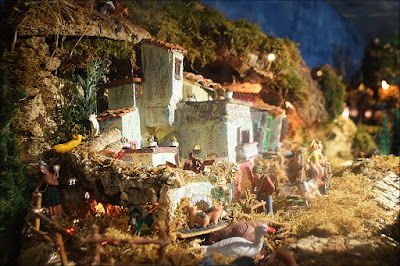 |
My lucky skivvies
|
December 31st is the Feast of San Silvestro il Primo (St. Sylvester the First), Pope (314-335) and Confessor. Widely venerated across Southern Italy, he is the principal patron of Sacco (SA), Cesinali (AV), Feroleto Antico (CZ), Cermignano (TE), and Castroreale (ME), among others.
According to tradition, he baptized and miraculously cured Emperor Constantine the Great of leprosy. A version of the story can be found in the renowned Sicilian folklorist Giuseppe Pitrè’s The Collected Sicilian Folk and Fairy Tales, a collection of Sicilian oral traditions. Even more amazingly, he is said to have subdued a pestilent dragon with the aid of the Blessed Mother.
By happenstance, the day coincides with New Year's Eve and has become somewhat entwined with the jubilant year-end celebration, so most of the popular traditions affiliated with La Festa di San Silvestro have more to do with the secular New Year than with the Saint's day.
Typical New Year's Eve celebrations in Southern Italy begin with dinner parties. And what better way to ring in the New Year than with a hearty meal with family and friends? Customarily lentils and pork sausages are served for dinner. It's said the food represents wealth and will bring good fortune to those who partake in the meal. In some households, figs are also exchanged so the coming year will be sweet as well. Afterward, people gather around bonfires or get together in the streets and squares to socialize and make merry. At midnight they watch huge fireworks displays. (The one in Naples is sheer pandemonium—watch YouTube video)
Of course, not all the rituals and folklore are related to food. In Naples, for example, some people still throw their old and broken household items out of their windows at midnight, taking the popular saying "Out with the old and in with the new" quite literally. This cleansing ritual symbolizes an optimistic fresh start.
The superstitious also believe smashing plates and glasses on the ground will frighten and chase away evil spirits. At the very least, its a cathartic release.
Wearing red underwear is another popular custom. The explanations for this curious practice are varied. For example, I've heard it said that red is a lucky color and it will bring prosperity to the wearer. Supposedly, it also symbolizes virility or fertility and is worn by those looking to have children or find romance.
Whatever the true meaning is, I won't be taking any chances and will be wearing mine when I ring in the New Year. Evviva San Silvestro! Ora pro nobis. Buon Anno! Happy New Year!
Prayer to St. Sylvester
O Loving Father and Saint Sylvester be a tower of strength to Your children, grant us increase, protect us from all harm and present, with your powerful intercession, our prayers to the Almighty. Pray for us, O Holy Father Saint Sylvester that we may be made worthy of promises of Christ. Be present to Your servants, O Lord, and through the intercession of our Holy Father Saint Sylvester, bestow upon us the unceasing help of Your grace so that, by following his example, we may be defended by Thy protection. Through Christ our Lord, Amen.





































































